Large-Scale Experimental Static Testing on 50-Year-Old Prestressed Concrete Bridge Girders
Abstract
1. Introduction
2. Case Study
2.1. Corso Grosseto Viaduct
2.2. BRIDGE|50 Research Project
2.3. Experimental Program
2.4. Material Properties
- Concrete of girders and slab: 15 compression tests on cylindric samples and 11 indirect tensile tests;
- Prestressing steel: 8 tensile stress tests.
3. Loading Test Setup
3.1. Reaction Steel Frame
3.2. Instrumentation
4. Test Results
4.1. Deflection Responses
4.2. Cracking
4.3. Decompression Load
4.4. Compressive Strains
4.5. Strand Slip
4.6. Shear Strains
5. Discussion
6. Conclusions
Author Contributions
Funding
Institutional Review Board Statement
Informed Consent Statement
Data Availability Statement
Acknowledgments
Conflicts of Interest
References
- Biondini, F.; Frangopol, D.M. Life-Cycle Design, Assessment and Maintenance of Structures and Infrastructure Systems; American Society of Civil Engineers (ASCE): Reston, VA, USA, 2019. [Google Scholar] [CrossRef]
- Biondini, F.; Frangopol, D.M. Life-cycle performance of deteriorating structural systems under uncertainty: Review. J. Struct. Eng. 2016, 142, 1–17. [Google Scholar] [CrossRef]
- Papè, T.M.; Melchers, R.E. The effects of corrosion on 45-year-old pre-stressed concrete bridge beams. Struct. Infrastruct. Eng. 2011, 7, 101–108. [Google Scholar] [CrossRef]
- Jeon, C.H.; Sim, C.; Shim, C.S. The effect of wire rupture on flexural behavior of 45-year-old post-tensioned concrete bridge girders. Eng. Struct. 2021, 245, 112842. [Google Scholar] [CrossRef]
- Eder, R.W.; Miller, R.A.; Baseheart, T.M.; Swanson, J.A. Testing of two 50-year-old precast post-tensioned concrete bridge girders. PCI J. 2005, 50, 90–95. [Google Scholar] [CrossRef]
- Lundqvist, P.; Riihimäki, J. Testing of five 30-year-old prestressed concrete beams. PCI J. 2010, 55, 50–58. [Google Scholar] [CrossRef]
- Taffe, A.; Hillemeier, B.; Walther, A. Condition Assessment of a 45-year-old prestressed concrete bridge using NDT and verification of the results. Struct. Mater. Technol. 2010. [Google Scholar] [CrossRef]
- Shenoy, C.V.; Frantz, G.C. Structural Tests of 27-Year-Old Prestressed Concrete Bridge Beams. PCI J. 1991, 36, 80–90. [Google Scholar] [CrossRef]
- Zwicky, D.L. Structural evaluation of 30-year-old prestressed concrete girders. In Proceedings of the 3rd International PhD Symposium in Civil Engineering, Vienna, Austria, 5–7 October 2000. [Google Scholar]
- Dasar, A.; Irmawaty, R.; Hamada, H.; Sagawa, Y.; Yamamoto, D. Prestress Loss and Bending Capacity of Pre-cracked 40 Year-Old PC Beams Exposed to Marine Environment. In Proceedings of the 3rd International Conference on Civil and Environmental Engineering for Sustainability (IConCEES 2015), Melaka, Malaysia, 1–2 December 2015. [Google Scholar] [CrossRef]
- Kramer, W.; Martin, W.; Viljoen, H. Demolition of Old Oak Bridge B4113: Condition of a 54-year old prestressed concrete bridge. In Proceedings of the International Conference on Concrete Repair, Rehabilitation and Retrofitting (ICCRRR 2018), Cape Town, South Africa, 19–21 November 2018. [Google Scholar] [CrossRef]
- Azizinamini, V.; Keeler, B.J.; Rohde, J.; Mehrabi, A.B. Application of a New Nondestructive Evaluation Technique to a 25-Year-Old Prestressed Concrete Girder. PCI J. 1996, 41, 82–95. [Google Scholar] [CrossRef]
- Halsey, J.T.; Miller, R. Destructive Testing of Two Forty-Year-Old Prestressed Concrete Bridge Beams. PCI J. 1996, 41, 84–93. [Google Scholar] [CrossRef]
- Jin-liang, L.; Yan-min, J. Destructive testing of twenty-year-old prestressed concrete bridge beams in freezing-thawing region. Civ. Eng. J. 2019, 3. [Google Scholar] [CrossRef]
- Rao, C.; Frantz, G.C. Fatigue tests of 17-year-old prestressed concrete bridge box beams. PCI J. 1996, 41, 74–83. [Google Scholar] [CrossRef]
- Recupero, A.; Spinella, N. Experimental tests on corroded prestressed concrete beams subjected to transverse load. Struct. Concr. 2019, 20, 2220–2229. [Google Scholar] [CrossRef]
- Pessiki, S.; Kaczinski, M.; Wescott, H.H. Evaluation of Effective Prestress Force in 28-Year-Old Prestressed Concrete Bridge Beams. PCI J. 1996, 41, 78–89. [Google Scholar] [CrossRef]
- Botte, W.; Vereecken, E.; Taerwe, L.; Caspeele, R. Assessment of posttensioned concrete beams from the 1940s: Large-scale load testing, numerical analysis and Bayesian assessment of prestressing losses. Struct. Concr. 2021, 22, 1500–1522. [Google Scholar] [CrossRef]
- Shu, J.; Bagge, N.; Nilimaa, J. Field Destructive Testing of a Reinforced Concrete Bridge Deck Slab. J. Bridge Eng. 2020, 25, 04020067. [Google Scholar] [CrossRef]
- Pepe, T.M.; Melchers, R.E. Performance of 45-year-old corroded prestressed concrete beams. Proc. Inst. Civ. Eng. Struct. Build. 2013, 166, 547–559. [Google Scholar] [CrossRef]
- Savino, P.; Anghileri, M.; Chiara, M.; Salza, B.; Quaranta, L. Corso Grosseto viaduct: Historical and technical overview. In Proceedings of the Tenth International Conference on Bridge Maintenance, Safety and Management (IABMAS 2020), Sapporo, Japan, 28 June–2 July 2020. [Google Scholar]
- Biondini, F.; Manto, S.; Beltrami, C.; Tondolo, F.; Chiara, M.; Salza, B.; Tizzani, M.; Chiaia, B.; Lencioni, A.; Panseri, L.; et al. BRIDGE|50 research project: Residual structural performance of a 50-year-old bridge. In Proceedings of the 10th International Conference on Bridge Maintenaince, Safety and Management (IABMAS 2020), Sapporo, Japan, 28 June–2 July 2020. [Google Scholar]
- Biondini, F.; Tondolo, F.; Manto, S.; Beltrami, C.; Chiara, M.; Salza, B.; Tizzani, M.; Chiaia, B.; Lencioni, A.; Panseri, L.; et al. Residual Structural Performance of Existing PC Bridges: Recent Advances of the BRIDGE|50 Research Project. In Proceedings of the First Conference of the European Association on Quality Control of Bridges and Structures (EUROSTRUCT 2021), Padua, Italy, 29 August–1 September 2021. [Google Scholar]
- Biondini, F.; Tondolo, F.; Manto, S.; Beltrami, C.; Chiara, M.; Salza, B.; Tizzani, M.; Chiaia, B.; Lencioni, A.; Panseri, L.; et al. Residual Structural Performance of a 50-Year-Old Viaduct in Italy—The BRIDGE|50 Project. In Bridge Maintenance, Safety, Management, Life-Cycle Sustainability and Innovations; CRC Press: Boca Raton, FL, USA, 2021. [Google Scholar]
- Anghileri, M.; Biondini, F.; Rosati, G.; Savino, P.; Tondolo, F.; Sabia, D.; Manto, S.; Nivriera, M.; Trincianti, C.; Ventura, D.; et al. Deconstruction of the Corso Grosseto viaduct and setup of a testing site for full scale load tests. In Proceedings of the Tenth International Conference on Bridge Maintenance, Safety and Management (IABMAS 2020), Sapporo, Japan, 28 June–2 July 2020. [Google Scholar]
- Ing, Massaro. Progetto esecutivo—Interscambio stradale Largo Grosseto; Repository of Turin Municipality; Ufficio Tecnico Lavori Pubblici Città di Torino—Ripartizione IV: Turin, Italy, 1970. [Google Scholar]
- Beltrami, C.; Bianchi, S.; Cervio, M.; Anghileri, M.; Felicetti, R.; Quattrone, A.; Chiara, M.; Salza, B.; Masala, D. Bridge visual inspections: Experience of local authorities and the case study of the Corso Grosseto viaduct. In Proceedings of the Tenth International Conference on Bridge Maintenance, Safety and Management (IABMAS 2020), Sapporo, Japan, 28 June–2 July 2020. [Google Scholar]
- Sabia, D.; Quattrone, A.; Tondolo, F.; Savino, P. Dynamic identification of damaged PC bridge beams. In Proceedings of the First Conference of the European Association on Quality Control of Bridges and Structures (EUROSTRUCT 2021), Padua, Italy, 29 August–1 September 2021. [Google Scholar]
- Sabia, D.; Quattrone, A.; Tondolo, F.; Savino, P. Experimental evaluation of the effect of controlled damages on the dynamic response of PC bridge beams. In Proceedings of the 11th International Conference on Bridge Maintenance, Safety and Management (IABMAS 2022), Barcelona, Spain, 11–15 July 2022. [Google Scholar]
- Anghileri, M.; Savino, P.; Capacci, L.; Bianchi, S.; Rosati, G.; Tondolo, F.; Biondini, F. Non-destructive testing and model validation of corroded PC bridge deck beams. In Proceedings of the First Conference of the European Association on Quality Control of Bridges and Structures (EUROSTRUCT 2021), Padua, Italy, 29 August–1 September 2021. [Google Scholar]
- Tondolo, F.; Biondini, F.; Sabia, D.; Rosati, G.; Chiaia, B.; Quattrone, A.; Savino, P.; Anghileri, M. Experimental program and full-scale load tests on PC deck beams. In Proceedings of the First Conference of the European Association on Quality Control of Bridges and Structures (EUROSTRUCT 2021), Padua, Italy, 29 August–1 September 2021. [Google Scholar]
- Tondolo, F.; Sabia, D.; Chiaia, B.; Quattrone, A.; Biondini, F.; Rosati, G.; Anghileri, M. Full-scale testing and analysis of 50-year old prestressed concrete bridge girders. In Proceedings of the 11th International Conference on Bridge Maintenance, Safety and Management (IABMAS 2022), Barcelona, Spain, 11–15 July 2022. [Google Scholar]
- Carsana, M.; Biondini, F.; Redaelli, E.; Valoti, D.O. On-site corrosion characterization of 50-year-old PC deck beams. In Proceedings of the First Conference of the European Association on Quality Control of Bridges and Structures (EUROSTRUCT 2021), Padua, Italy, 29 August–1 September 2021. [Google Scholar]
- Carsana, M.; Valoti, D.O.; Redaelli, E.; Biondini, F. Corrosion assessment of 50-year-old PC deck beams. In Proceedings of the 11th International Conference on Bridge Maintenance, Safety and Management (IABMAS 2022), Barcelona, Spain, 11–15 July 2022. [Google Scholar]
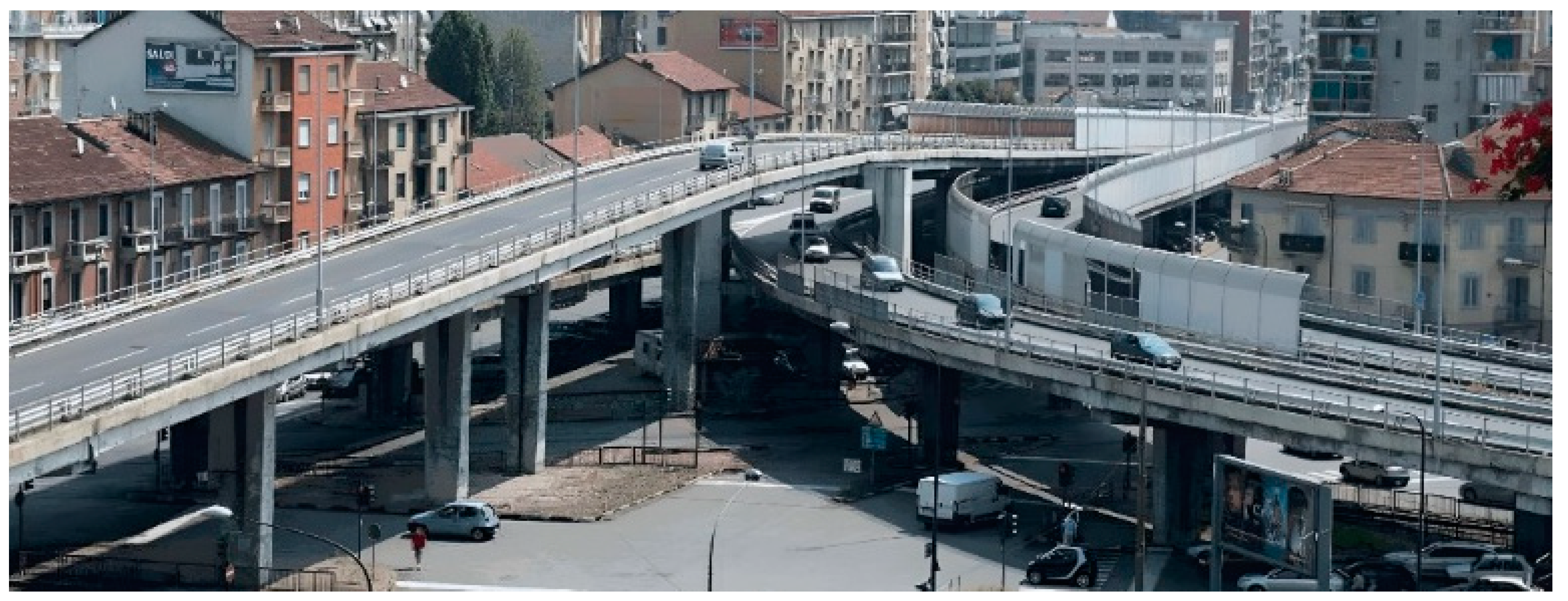
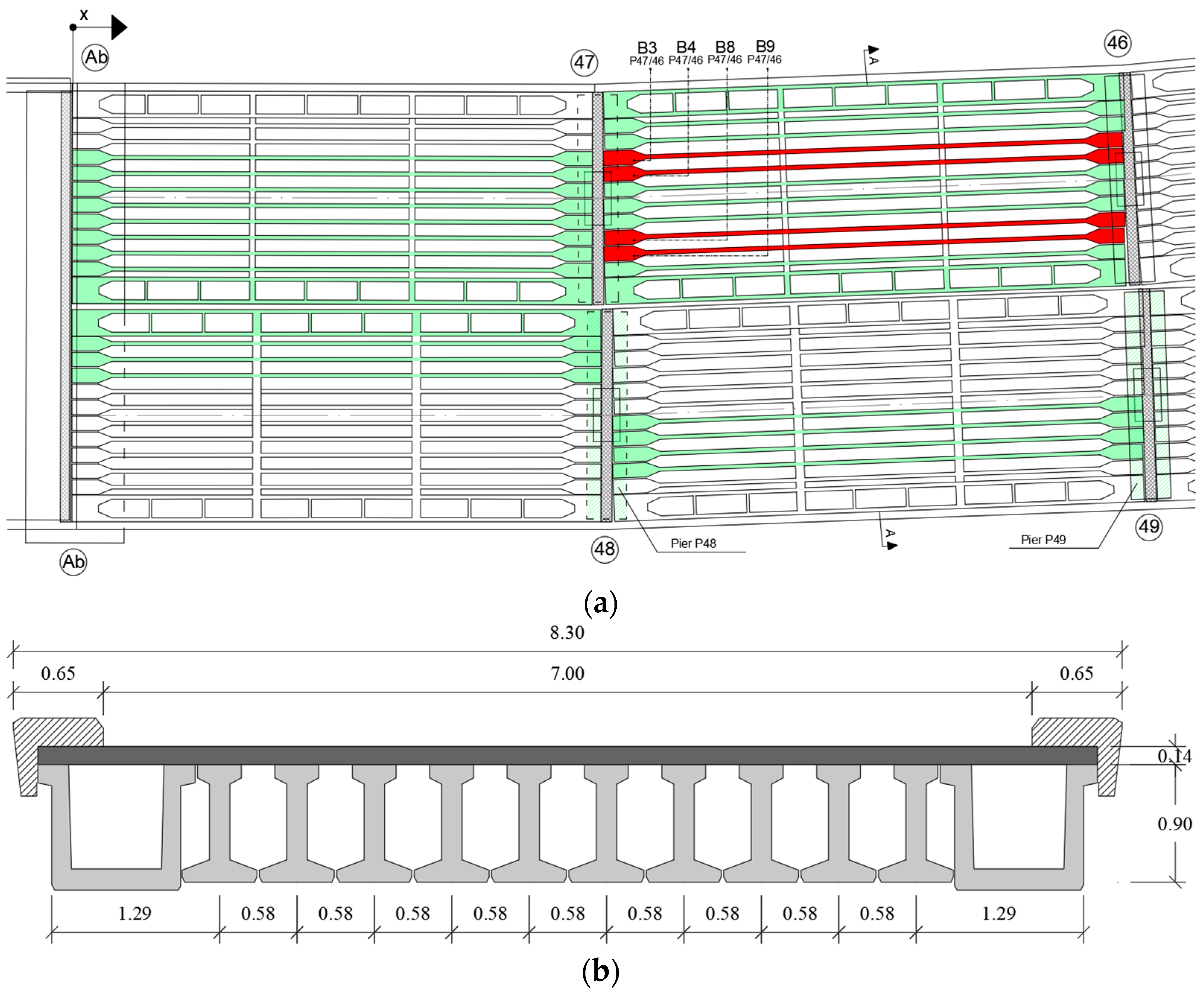
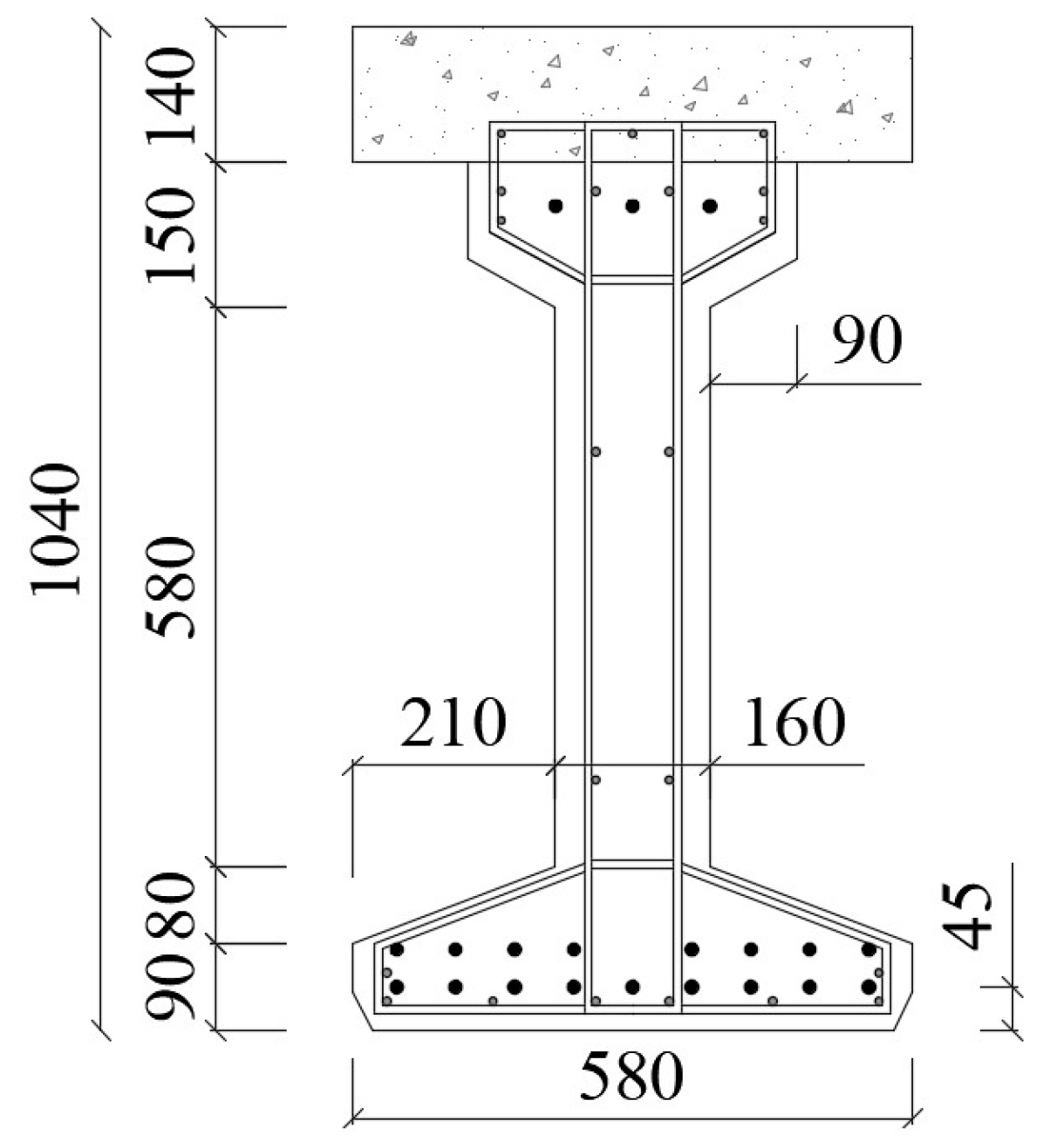
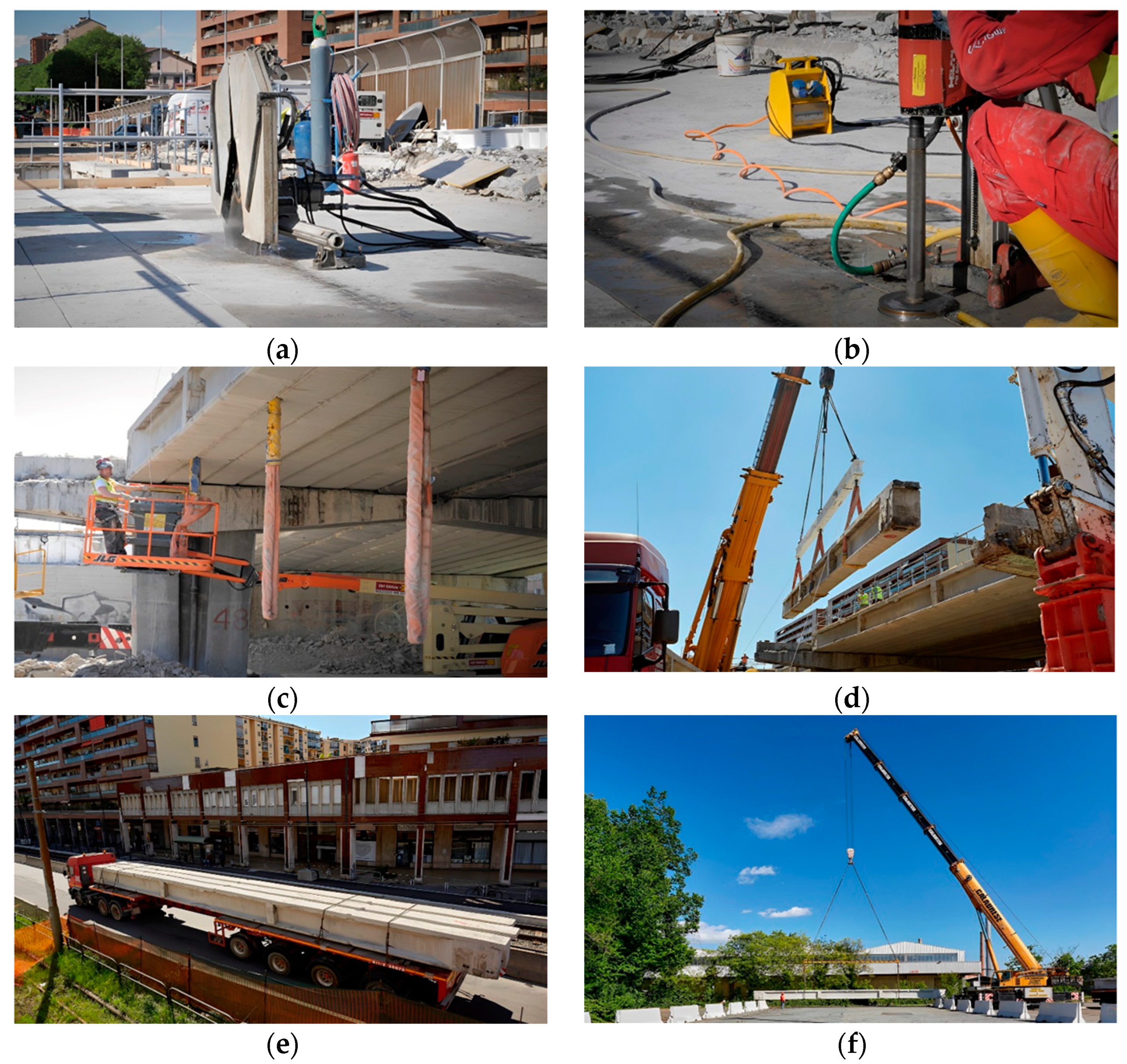
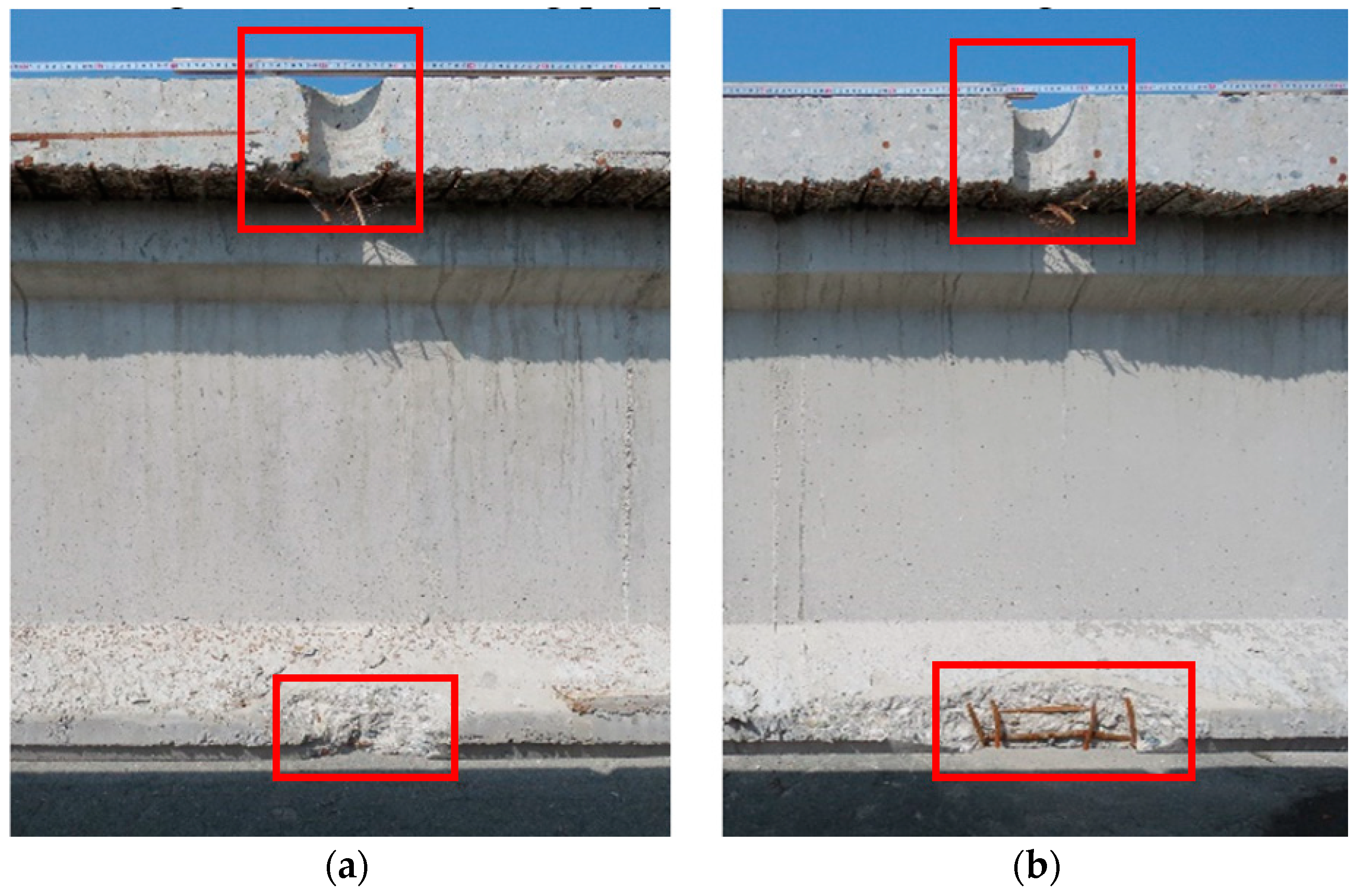
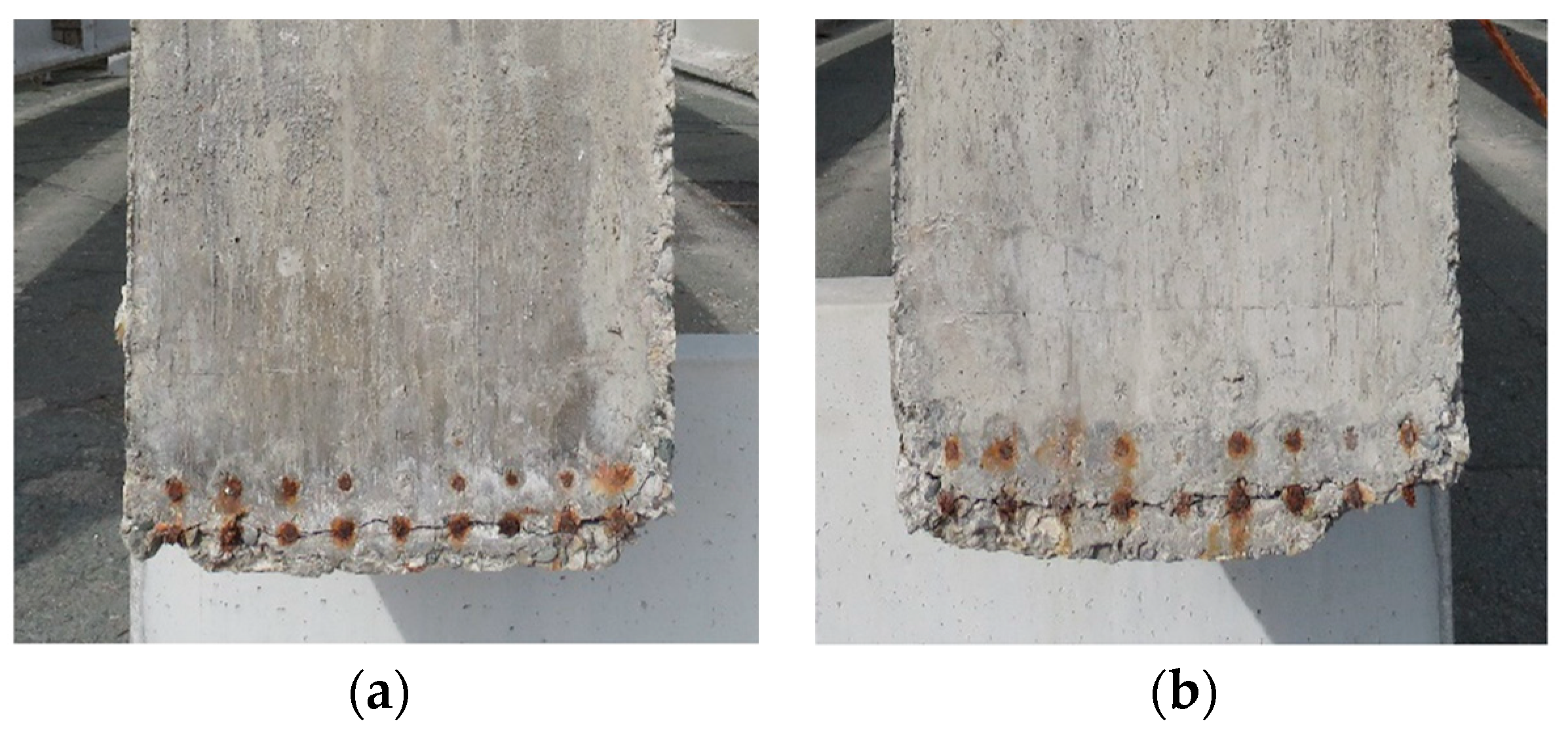

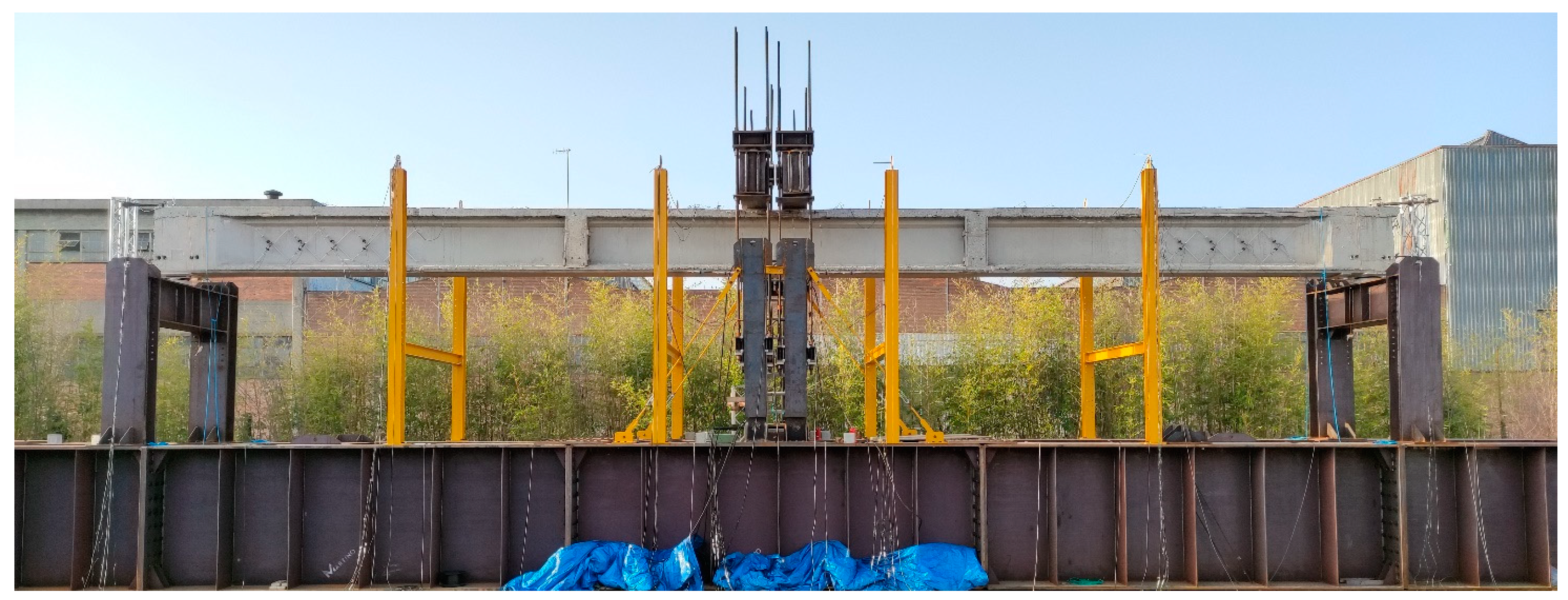
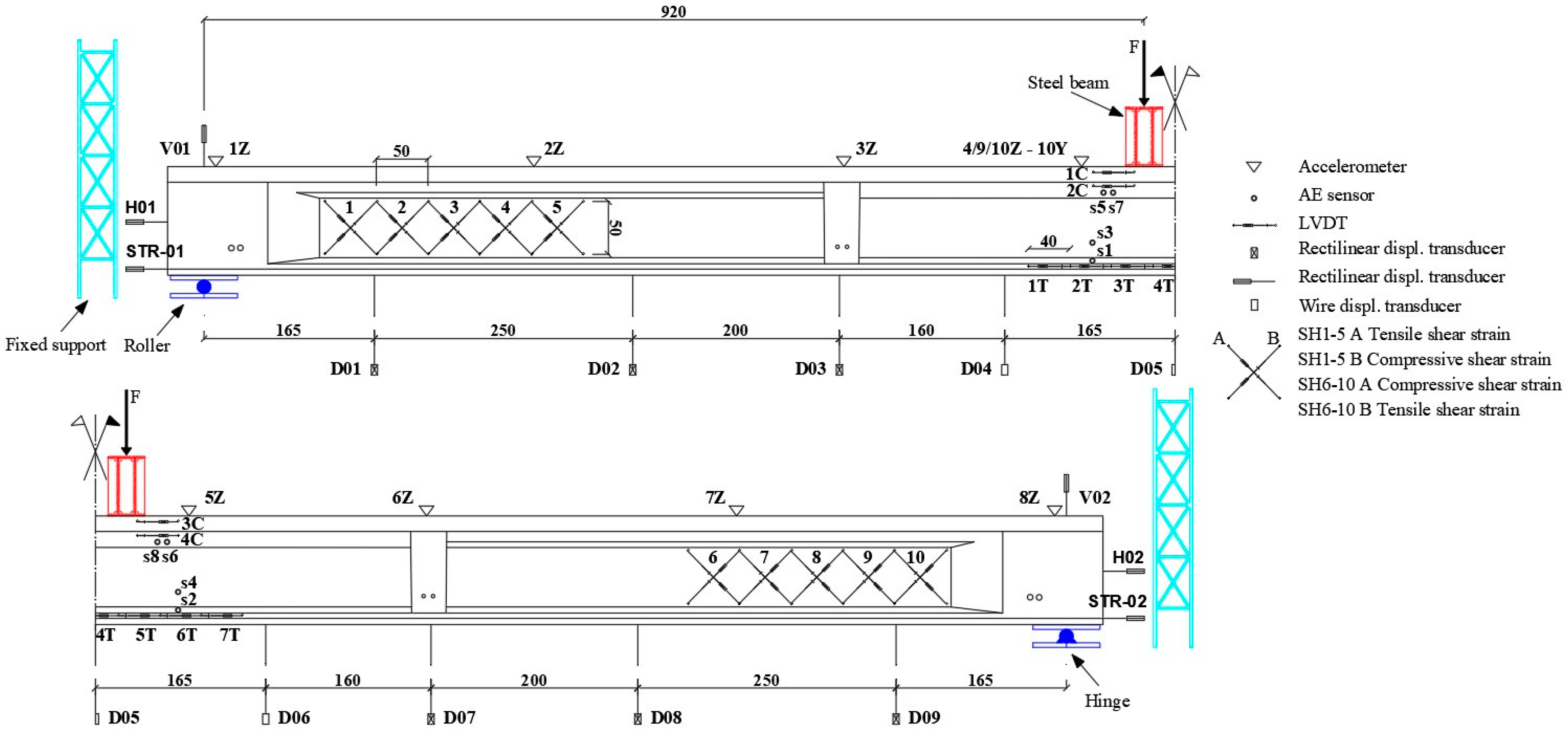

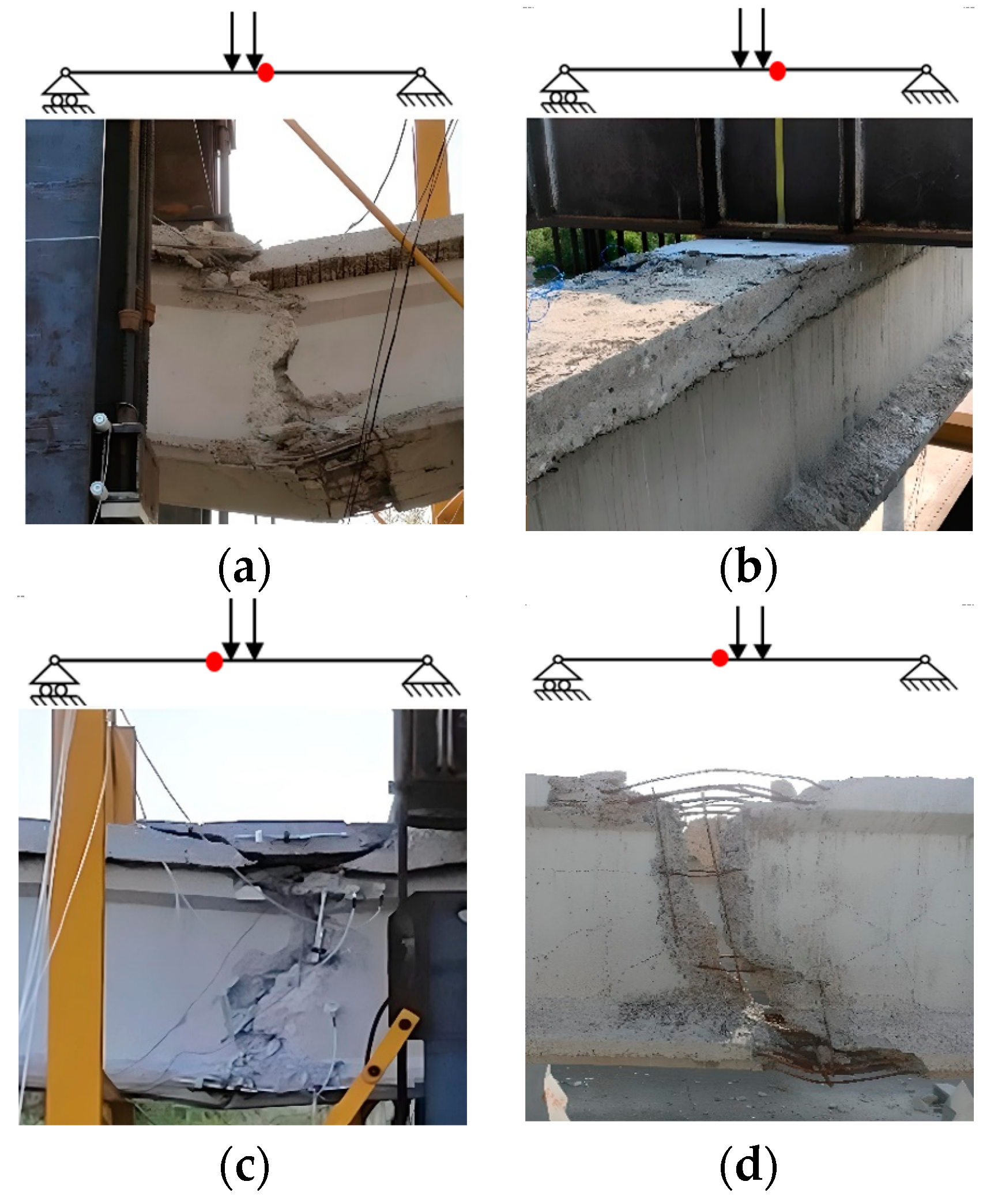
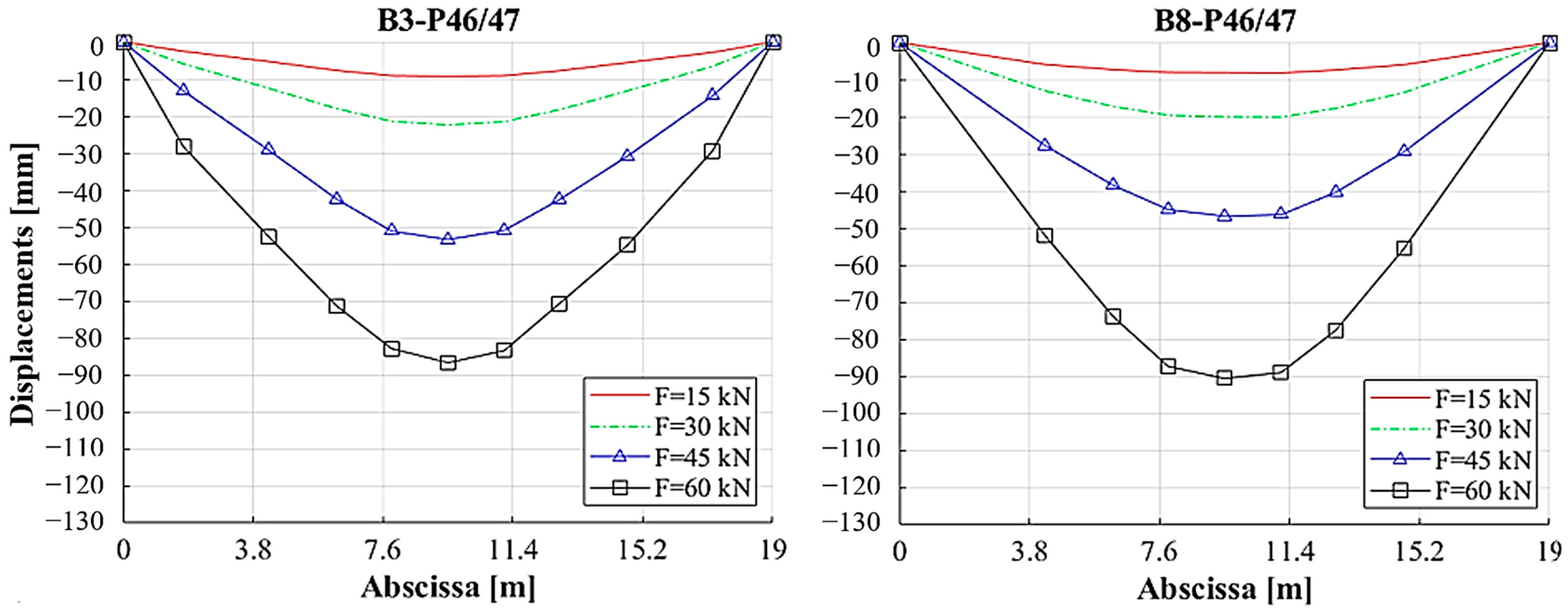
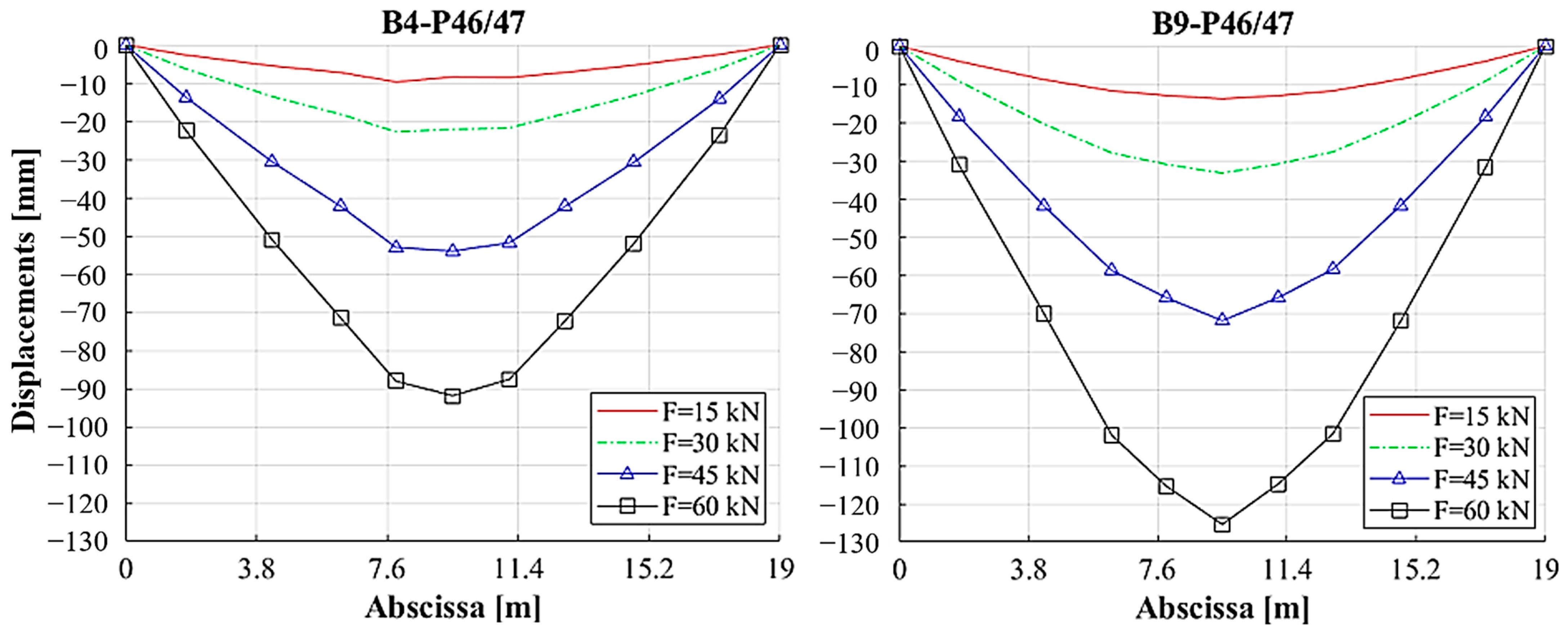
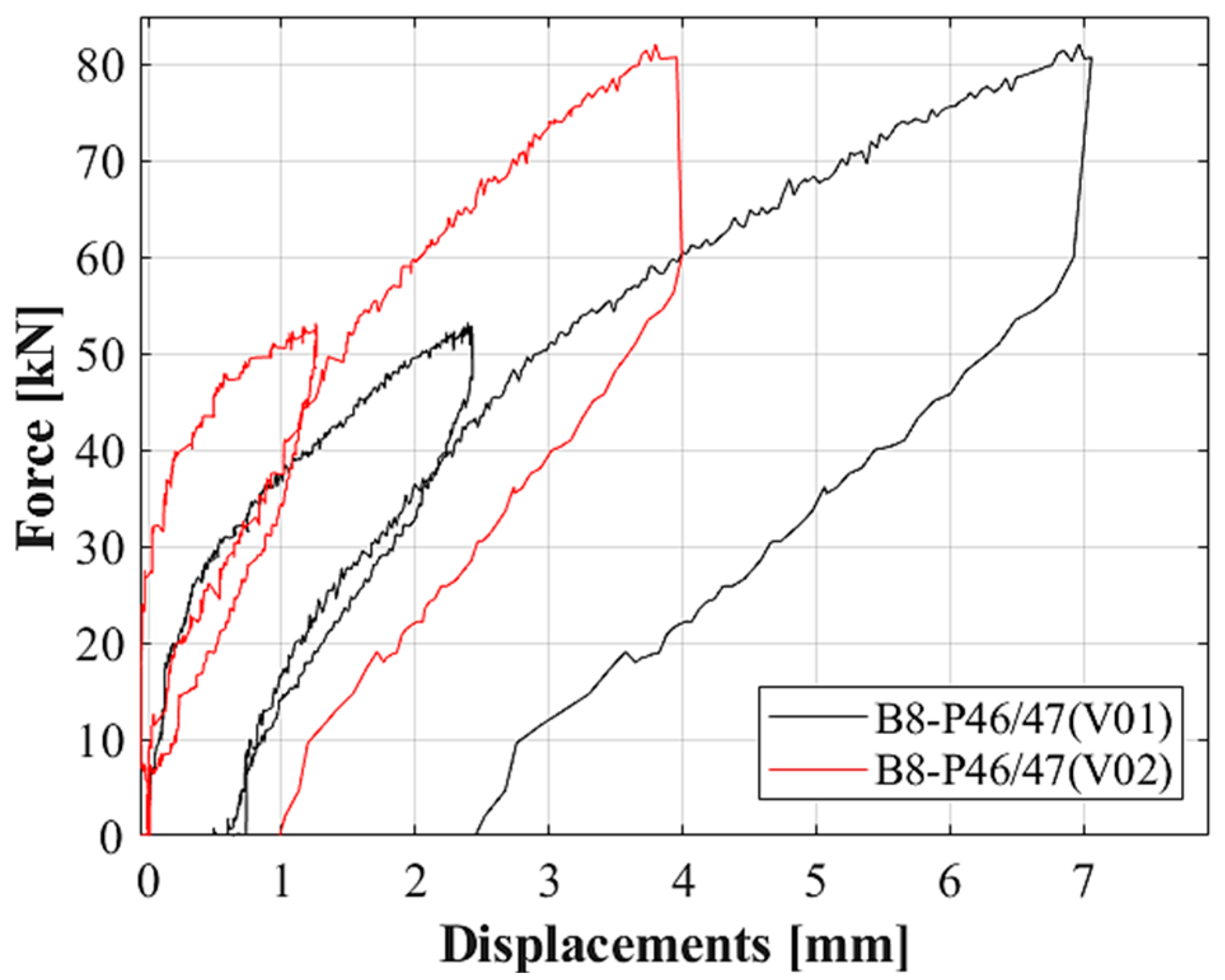
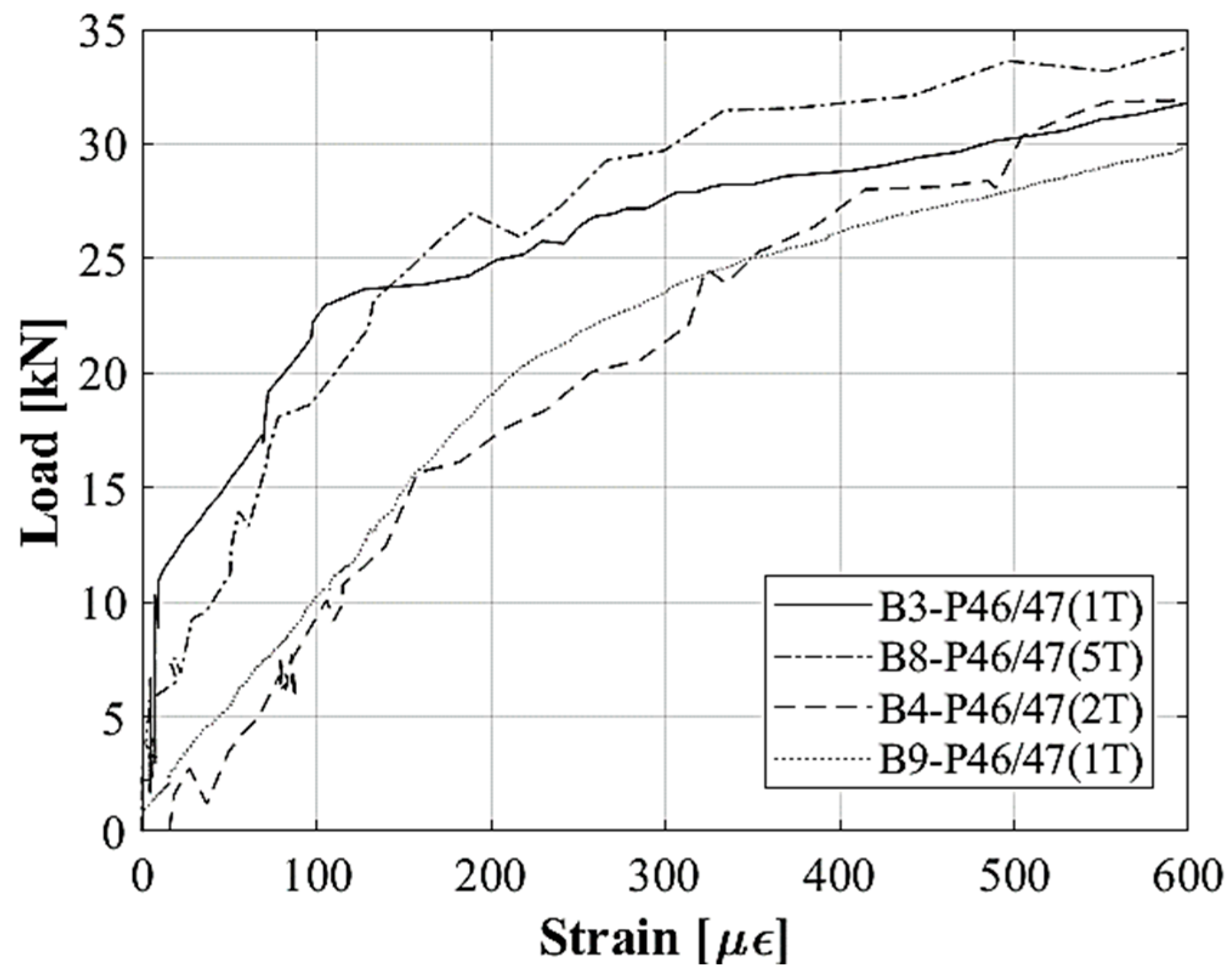
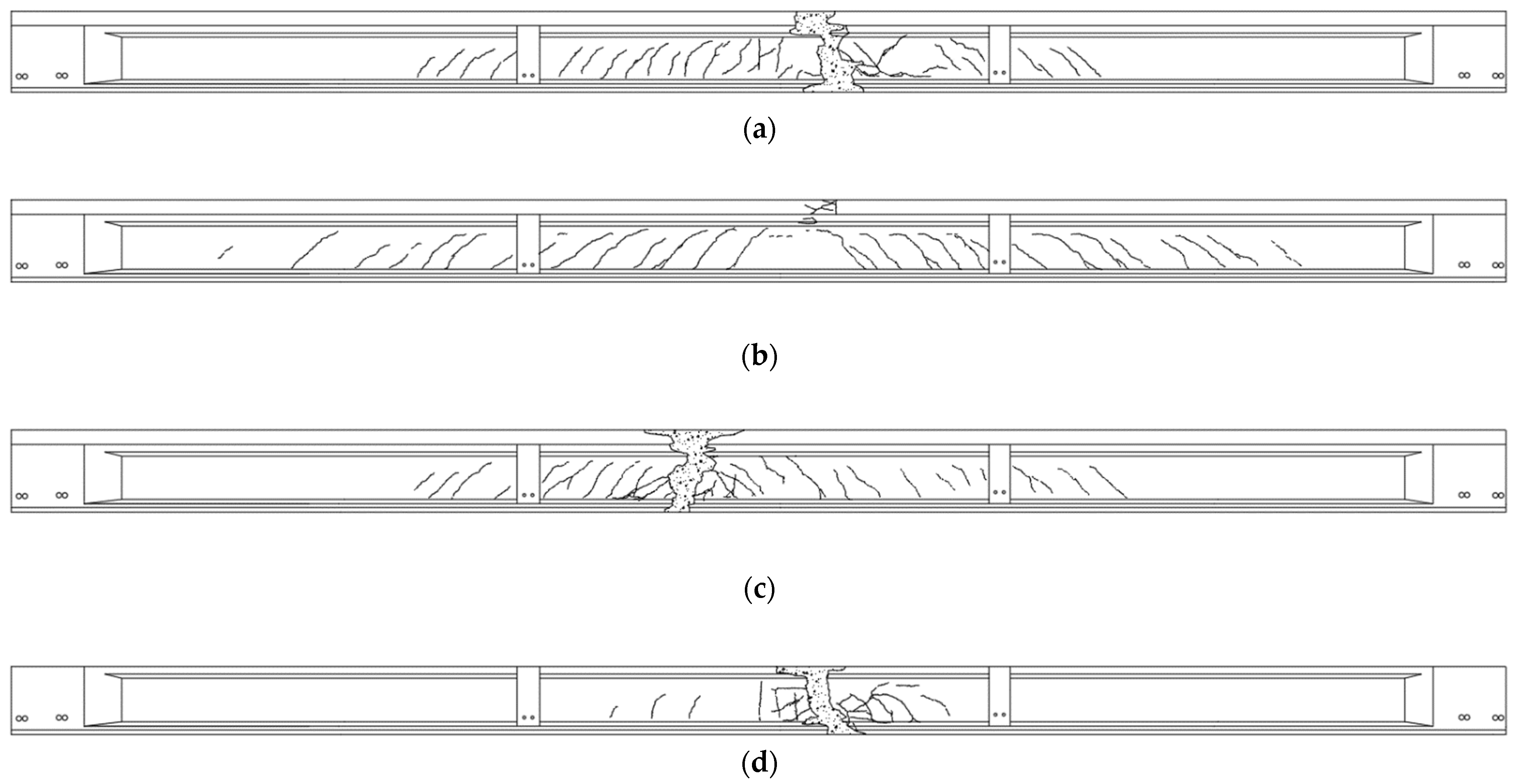
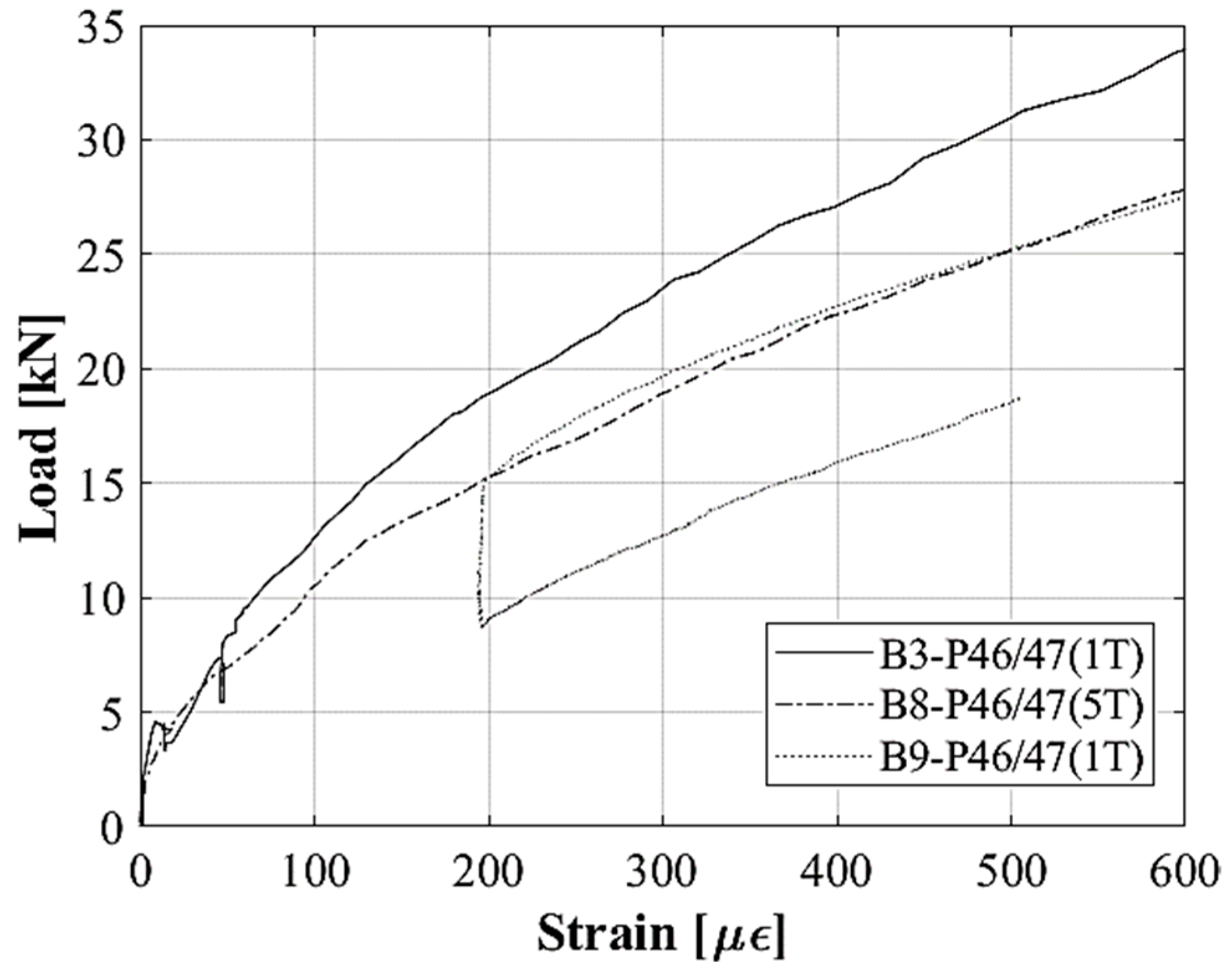

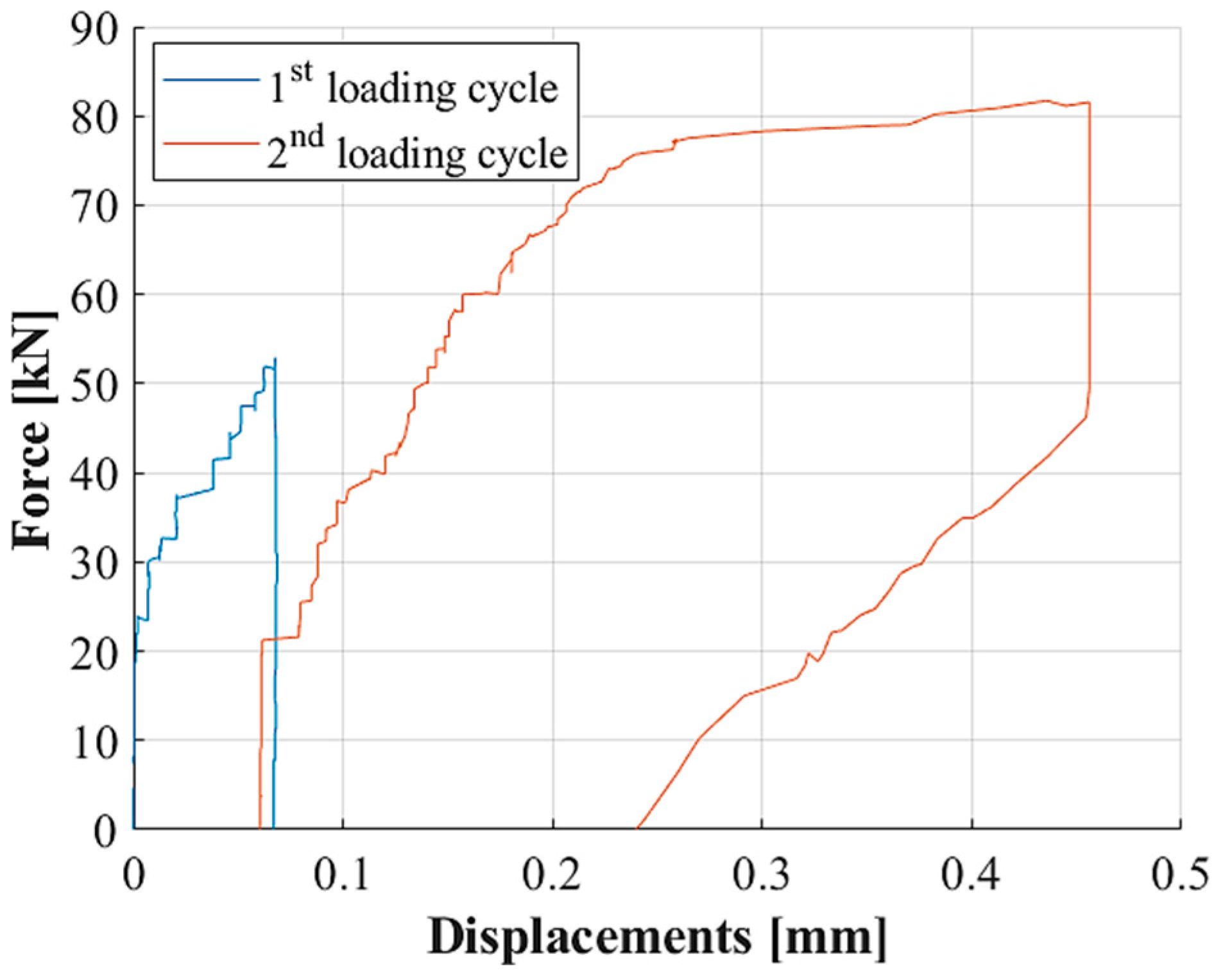
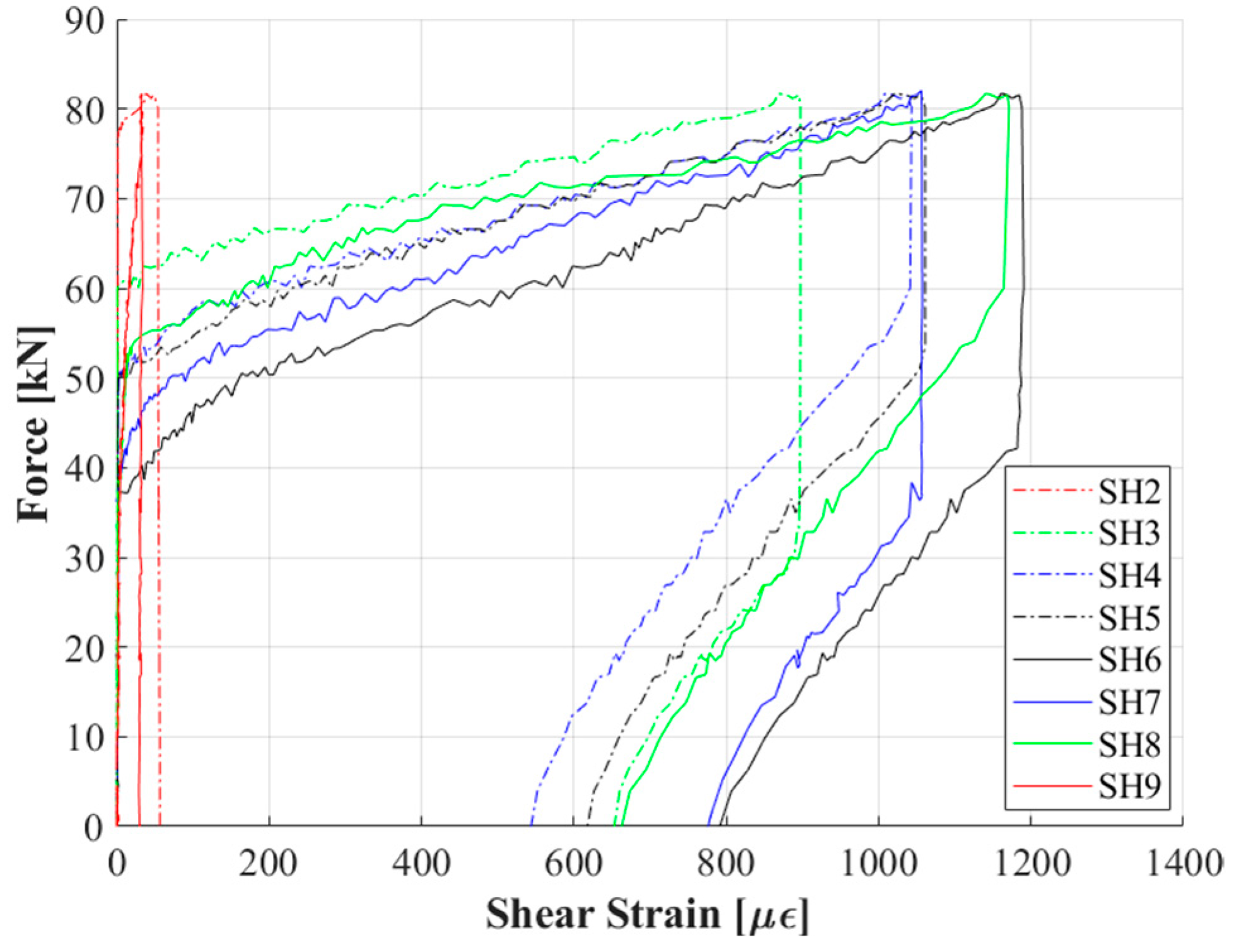
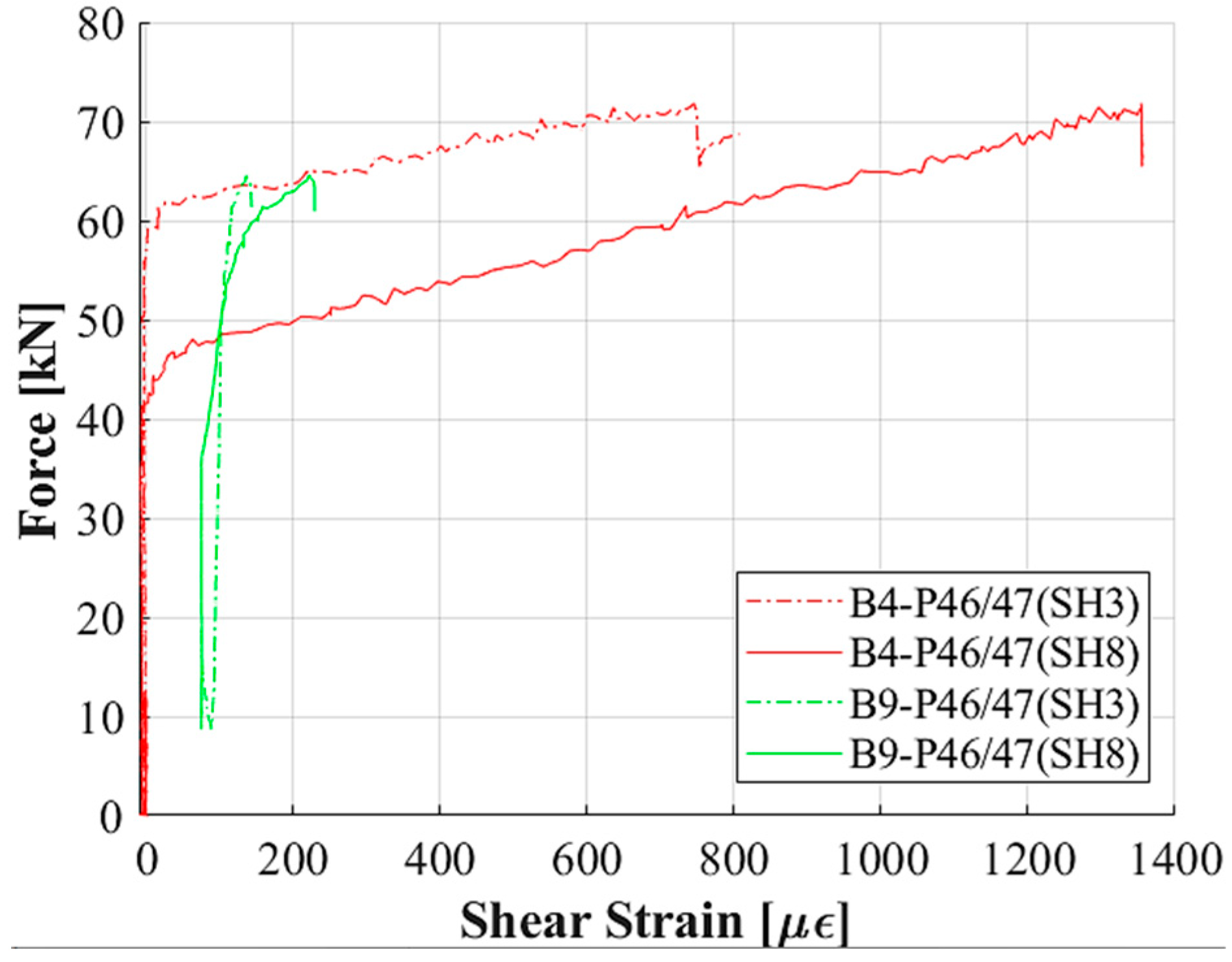
| Load Test | Beam Code | Loading Phases | Concrete Cross-Section |
|---|---|---|---|
| 1 | B3-P47/46 | 2 | Composite |
| 2 | B8-P47/46 | 2 | Composite |
| 3 | B4-P47/46 | 1 | Composite |
| 4 | B9-P47/46 | 2 | I-beam |
| Location | Material | Property | Test | No. | Unit | Mean Value | Standard Deviation |
|---|---|---|---|---|---|---|---|
| Slab | Concrete | Compressive strength | Compression | 5 | MPa | 21.9 | 4.7 |
| Slab | Concrete | Tensile strength | Indirect tensile test | 2 | MPa | 2.4 | 0.9 |
| Girder | Concrete | Compressive strength | Compression | 10 | MPa | 33.6 | 6.7 |
| Girder | Concrete | Tensile strength | Indirect tensile test | 9 | MPa | 3.4 | 0.5 |
| Girder | Prestressing steel | Yield strength | Tensile | 8 | MPa | 1521.5 | 68.0 |
| Girder | Prestressing steel | Ultimate tensile strength | Tensile | MPa | 1763.4 | 60.1 | |
| Girder | Prestressing steel | Elongation at maximum load | Tensile | % | 3.4 | 1.1 |
| Parameters | Sensor | Location | No. |
|---|---|---|---|
| Deflection | Wire displ. transducer | D04-06 | 3 |
| Deflection | Displ. potentiometer transducer | D01-03 D07-09 | 6 |
| Displacement | Linear displ. transducer | V01-02 H01-02 | 4 |
| Strand sliding | Linear displ. transducer | STR-01/02 | 2 |
| Shear strain | Linear variable displ. Transducer 1 | 1-10 | 20 |
| Bending strain | Linear variable displ. Transducer 1 | 1T-7T 1C-4C | 11 |
| Bending strain | Strain gauge | 2C-1T | 2 |
| Acceleration | Accelerometer | 1-10Z 10Y | 10 |
| Acoustic emission | PZT transducer | Midspan | 8 |
| Load | Load cell | Hydraulic jacks | 3 |
Disclaimer/Publisher’s Note: The statements, opinions and data contained in all publications are solely those of the individual author(s) and contributor(s) and not of MDPI and/or the editor(s). MDPI and/or the editor(s) disclaim responsibility for any injury to people or property resulting from any ideas, methods, instructions or products referred to in the content. |
© 2023 by the authors. Licensee MDPI, Basel, Switzerland. This article is an open access article distributed under the terms and conditions of the Creative Commons Attribution (CC BY) license (https://creativecommons.org/licenses/by/4.0/).
Share and Cite
Savino, P.; Tondolo, F.; Sabia, D.; Quattrone, A.; Biondini, F.; Rosati, G.; Anghileri, M.; Chiaia, B. Large-Scale Experimental Static Testing on 50-Year-Old Prestressed Concrete Bridge Girders. Appl. Sci. 2023, 13, 834. https://doi.org/10.3390/app13020834
Savino P, Tondolo F, Sabia D, Quattrone A, Biondini F, Rosati G, Anghileri M, Chiaia B. Large-Scale Experimental Static Testing on 50-Year-Old Prestressed Concrete Bridge Girders. Applied Sciences. 2023; 13(2):834. https://doi.org/10.3390/app13020834
Chicago/Turabian StyleSavino, Pierclaudio, Francesco Tondolo, Donato Sabia, Antonino Quattrone, Fabio Biondini, Gianpaolo Rosati, Mattia Anghileri, and Bernardino Chiaia. 2023. "Large-Scale Experimental Static Testing on 50-Year-Old Prestressed Concrete Bridge Girders" Applied Sciences 13, no. 2: 834. https://doi.org/10.3390/app13020834
APA StyleSavino, P., Tondolo, F., Sabia, D., Quattrone, A., Biondini, F., Rosati, G., Anghileri, M., & Chiaia, B. (2023). Large-Scale Experimental Static Testing on 50-Year-Old Prestressed Concrete Bridge Girders. Applied Sciences, 13(2), 834. https://doi.org/10.3390/app13020834







